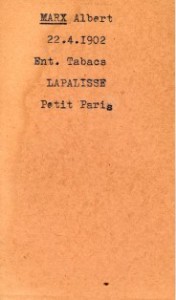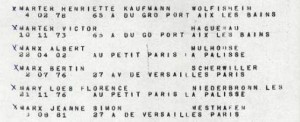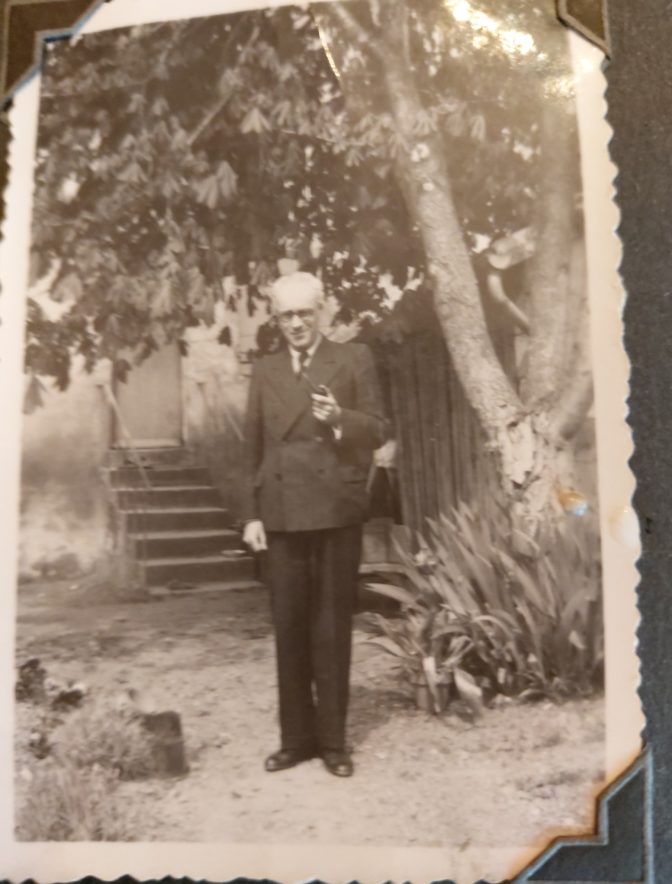Albert MARX
This photograph of Albert Marx, taken in 1944, is from the family archives. A second family photograph shows Albert with his sister Madeleine, in 1923 (see below).
Albert Marx was born on April 22, 1902 in Mulhouse, in the Alsace region of France.
His mother, Florentine Loeb, often called Florence, was the daughter of Aron Loeb, a textile merchant from Reichshoffen in Alsace. After his first marriage to Sophie Kauffmann, who died in 1856 and with whom he had three children, he married Françoise (called Fanny in the German records) Hemmerdinger, originally from Fegersheim, Alsace, on February 7, 1865. They lived in Niederbronn, Alsace. They had five daughters. Florence was the last of them. She was born on November 21, 1876 in Niederbronn-les-Bains.
She was married at the age of 24 on July 8, 1901 in Niederbronn-les-Bains to Simon Marx, who was 31 years old and born in Mulhouse on September 28, 1869. He was the second of four siblings. The couple lived in Mulhouse. They had two children there: Albert, who was born in 1902, and Madeleine, who was born in 1905 and was the only one to survive the Holocaust.
Simon, who studied Fine Arts in Mulhouse, was a fabric designer and sales representative. He worked for the Lentz company. He traveled throughout Central Europe, the Balkans, the Scandinavian countries and even as far as Algeria.
A lover of literature, his wife Florence was part of the intellectual and social circles in Mulhouse. She even wrote a few articles that were published in a newspaper in Geneva, where one of her sisters lived. However, she was also an outstanding pastry chef.
They moved to Strasbourg before 1920. We are not sure exactly when they moved, but Albert, the elder, did his secondary studies at the Kléber High School in Strasbourg while Madeleine studied literature in Geneva in 1920 and then went to the Pigier School in Strasbourg in 1921.
In 1920, the city of Strasbourg published a directory in which Simon Marx was listed at 19, boulevard Clemenceau. This was their last known address prior to their departure in 1939.
Albert then attended the Tobacco School. He then went to do his military service. There is a photo of him in the army in 1923, in the Rhineland. In fact, after Germany was defeated in 1918, the Allies occupied the Ruhr valley. During his time there, Albert came into contact with the local German population, who he tried to understand and assess objectively. Albert was a man who loved the arts, music, painting and literature. One of his friends was Wilheim Weyler, who went on to become the director of Ben-Hur under the name of William Wyler, and another was Charles Walch, a painter and engraver. He also liked to travel, and documented his trips with a large number of photos. These provide us with a wealth of information about his travels and the places he visited. In 1924, he went to work for the Tobacco authority in Algiers. His father Simon visited him around 1926.

Albert and his sister Madeleine in 1923, from the family archives.
He stayed in Algiers until 1927, when he crossed the Suez Canal on his way to Madagascar, where he was appointed Director of Tobacco.
The island was still quite wild and each trip was like an expedition, so precarious were the means of communication and transportation. These trips, on which he was accompanied by his native porters, were in keeping with his somewhat wild and secretive temperament.
This rather reserved man from Alsace, who was never very effusive or demonstrative, spoke fondly of the great island in the southern hemisphere, and with great enthusiasm about the tough treks in the bush, which were such a striking contrast to the easy life of a colonial civil servant at the time.
The journey to France was long and Albert seldom returned home. When he did come, however, he would stay at least six months. In 1930, in his photo album, we find souvenirs of Alsace, Germany, Italy and Paris. In 1931, he was in Constantine, Algeria, and then in June and July he was aboard the ship “Jean Laborde”, bound for Madagascar. He stayed there until 1934. He then travelled again, this time to the Comoro Islands, Mayotte, Zanzibar, Beirut, Marseille, the Italian Tyrol, the Dolomites and Strasbourg. In 1935 he returned to Madagascar, where he stayed until August 1938. He then returned to France on vacation on the “l’Explorateur Grandidier”, on which, according to his most recent photos, he met a group of “Yemeni Jews on their way to Palestine”.
On his return to France, he was appointed Director of Tobacco in Pont de Beauvoisin, where there was a large Tobacco board.
At the beginning of 1939, before war was declared, his brother-in-law Robert Blum, his sister Madeleine and their son Pierre moved to Vichy, in central France. When Strasbourg was evacuated, their parents, Simon and Florence Marx, went to live with them in their apartment at 30, rue Mounin. Albert then went to join them.
In July 1940, the French government moved its headquarters to Vichy. In June 1941, the family split up. Robert, Madeleine and Pierre moved to Valence, also in the free zone. However, Simon and Florence, together with their son Albert, went with some friends from Mulhouse, the Uhlmann family, to seek refuge in Lapalisse, in the Allier department. There they registered themselves as French Jews, as required by the French government’s anti-Jewish law of June 2, 1941.

Source: Allier departmental archives, record number 756W1
On this document, we see that Simon Marx was staying in the Sisters of Lapalisse hospital. He died there on June 11, 1942. Madeleine, his daughter, had his body repatriated at the end of the war and he was then buried in the Cronenbourg Jewish cemetery in Strasbourg.
Florence and Albert were living in a nearby hamlet called Petit Paris.

Source: Allier departmental archives, record n° 996 W 778 W 112.
A witness told Madeleine that during a roundup on June 30, 1944, Albert went down to see what was going on and spoke to a Nazi in perfect German. The soldier asked him for his identity documents.
They had no false ID and thus were arrested during this roundup, which was organized by the collaborator Georges Jany Batissier, a former police commissioner.
This collaborator, Batissier, alias Captain Schmidt, set up a brigade of twenty-two French agents for Hugo Geissler, the head of the Nazi police in Vichy. It was in his role as leader of this brigade, along with the Nazis, that he went to Lapalisse on June 30, 1944.
They were interned at La Mal-Coiffée, a German military prison in Moulins, until July 15, when they were transferred to Drancy camp, where Albert was registered as number 25146.
They were deported from Drancy to Auschwitz on July 31, 1944 on Convoy 77. Albert was murdered on August 5, 1944 in Auschwitz. Some records, however, give his date of death as July 31, 1944.

Source of the record above: Shoah Memorial, record number C77_41
Albert Marx wrote two novels, a play and several short stories. His first novel, Feu et Lumière, dates from 1919. Les Créneaux D’Ilion, written in 1933, is about an unhappy love affair and is set in Madagascar. Fidélité and Gertrude et le colombophile are two of the short stories.
In 1938, in Madagascar, he wrote an article called Du côté de chez Rakoton for a local magazine in Tananarive.
Femme de prisonnier was a play in three acts, written in 1942. In it, the writer sympathizes with the prisoners’ suffering and expresses his hope that a new world would emerge from the hell in which they were living at the time and that the next generation would enjoy a brighter future.
Albert Marx’ name appears on the list of writers who died for France at the Pantheon in Paris.

Stolpersteine bearing the names of Albert and his mother, Florentine, have been laid at 19, Boulevard Clémenceau in Strasbourg.
Robert, Madeleine, Alain and Pierre Blum all survived the Shoah. Pierre was my (Karine Benarroch) father. This biography was made possible through Alain and Pierre’s recollections as well as those of Madeleine, which she passed on to her grandchildren, and the biography of our cousin Andrée R. Picard, a translator at Gallimard, a French publishing house.
[:pl]
Albert MARX
Il quitte Pont-de-Beauvoisin (Isère) pour rejoindre ses parents à Lapalisse (03) où ils sont domiciliés au lieudit «Le Petit Paris».Ils se font recenser à Lapalisse en tant que Juifs français conformément à la loi antisémite du 2 juin 1941 de l’Etat Français […][kleo_button title=”Lire l’intégralité de la biographie sur le site de l’AFMD” href=”http://afmd-allier.oxatis.com/PBCPPlayer.asp?ID=1010351″ style=”highlight” target=”blank”]


 Français
Français Polski
Polski









